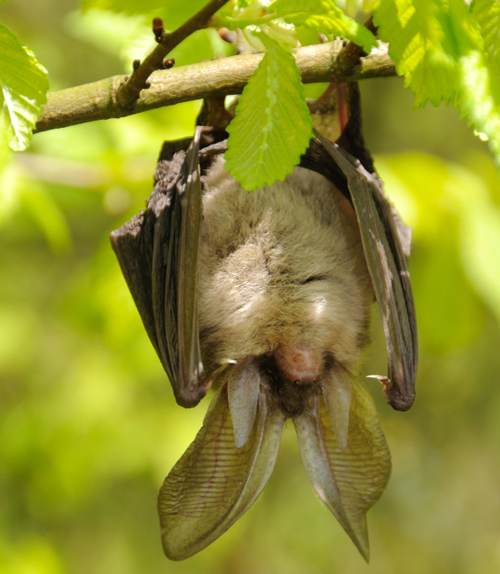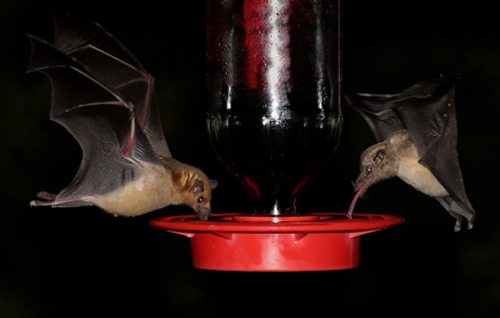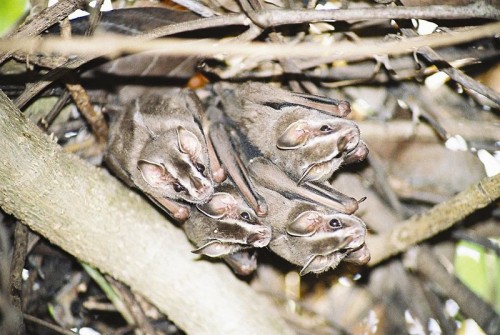UPDATED on October 30, 2018.

Bats are one of the most beneficial animals on the planet: 70% of the world’s bat species feed on insects — and one bat can consume up to 1,000 insect pests in an hour.
Bats also play a critical role in pollination and seed dispersal.
Sadly, in North America, millions of bats have died from white-nose syndrome (WNS) since 2006. White-nose syndrome is a disease that affects hibernating bats and is caused by a fungus, Pseudogymnoascus destructans, or Pd for short. As of 2011, an estimated 6.7 million bats had already perished, and as of 2018, the actual death toll remains unknown, says the White-Nose Syndrome Response Team.
Want to learn more about bats? Get started with these ten bat facts, along with a few photos celebrating the unique beauty of these amazing mammals. Enjoy!

Bat fact 1: Bats are the only mammal capable of true flight. Other mammals may glide, but bats actually fly. The elongated fingers of the bat’s wing are anatomically similar to the human hand.
Bat fact 2: Bats’ knees face backwards. The position of bats’ knees aids in the bat’s ability to navigate in flight and to hang by its feet. Bats cling to their roosts without expending energy, using specialized tendons that hold their toes in place. In order to let go of the roosting surface, bats must flex their toe muscles.
Bat fact 3: Bats are not rodents. Bats are not even closely related to rodents. Although a shrew-like ancestor is shared by bats and primates, bats belong to their own group, the Chiroptera, which means “hand-wing”. According to the University of California Museum of Paleontology, “bats are also related to the Primates, the mammal taxon that includes lemurs, monkeys, apes, and humans; and to the Scandentia, the Asian tropical tree shrews. All these mammals are sometimes classified together in one large taxon, the Archonta.”

Bat fact 4: Vampire bats do not suck blood; they simply lap it up like a dog or cat drinking water. Vampire bats feed almost exclusively on blood, mainly from cattle, horses, and wild mammals. To access its food, a vampire bat uses its teeth to pierce the skin of an animal while it sleeps and consumes just two tablespoons of blood. Vampire bats rarely bite humans, although a blood anticoagulant found in vampire bat saliva is being tested to help treat stroke victims.
Bat fact 5: Bats keep themselves extremely clean. Fastidious bats will groom themselves for hours.

Bat fact 6: Although they have relatively good eyesight, insectivorous Microchiroptera (microbats) use echolocation to find prey and avoid objects and predators in the darkness. Bats create sounds using their mouth or nose, and when the sound hits an object, an echo bounces back to the bat. Using echolocation, a bat can detect and avoid an object no wider than a piece of thread.

Bat fact 7: Megachiroptera (megabats) such as flying foxes do not use echolocation like other bats. Flying foxes — a group of Old World bats found in Australia, Africa, and Asia — locate their diet of ripe fruit using eyesight and an excellent sense of smell.
Bat fact 8: Bats have a lifespan of 20 to 30 years. The lifespan of a bat is the longest for any mammal of their size.

Bat fact 9: Most bat species produce just one offspring per year. Their slow reproductive rate makes bats especially vulnerable to extinction. A baby bat is called a “pup”.
Bat fact 10: There are over 1,100 species of bats in the world. Bats comprise nearly 25% of all mammal species. More than 50% of the 45 bat species in the U.S. are in decline.
Bats in peril: White-nose syndrome (WNS)

One of the most urgent issues facing bats in the U.S. is White-nose Syndrome. This devastating disease is wiping out bat populations at an alarming rate, putting several bat species at risk of extinction. According to biologists, White-nose Syndrome has caused “the most precipitous wildlife decline in the past century in North America”.
While they are in the hibernacula, affected bats often have white fungus on their muzzles and other parts of their bodies. They may have low body fat. These bats often move to cold parts of the hibernacula, fly during the day and during cold winter weather when the insects they feed upon are not available, and exhibit other uncharacteristic behavior.
To learn more about what you can do to help protect bats, visit the Bat Conservation International and White-noseSyndrome.org.
Images: Diaemus youngi By Gcarter2 via Wikimedia Commons; all others iStockphoto.com, unless otherwise noted.
Sources:
- U.S. Fish & Wildlife Service
- White-noseSyndrome.org
- Organization for Bat Conservation
- HSUS
- Encyclopedia Smithsonian
- Defenders of Wildlife
- Bat Conservation International
Adapted from Bats: 10 Essential Bat Facts, Plus Photo Gallery! by Rhishja Cota-Larson, originally published 27 October 2009 on Ecolocalizer.




